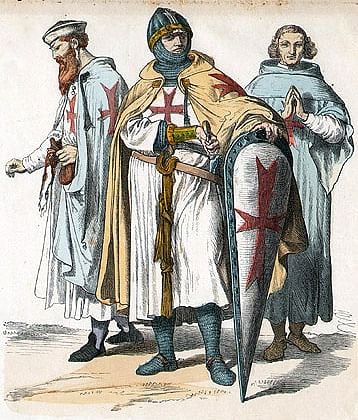
Masonic Articles and Essays
The Crusades and Freemasonry
Bro... Albert S. Hovan, P.D.D.G.M.
Date Published: 2/18/2022
Much has been made of the connection between the Knights Templar and Freemasonry yet mystery abounds and the true purpose of their mission in the Holy Land remains unknown and a topic of persistent speculation.
The Crusades have no relation to Freemasonry, even though there are concordant bodies which base their rituals on the Crusades and have taken the name of the original Crusaders, the Knights Templar. Among the historic Crusaders there were in fact two groups, first being The Religious Order of the Hospital of Saint John of Jerusalem, and later the Order of the Knights Templar. In the area of discipline and administration, both orders were military.
The Religious Order of the Hospital of Saint John of Jerusalem started with the establishment of a small hospital or hospice in Jerusalem, to treat pilgrims visiting the holy city, early in the 6th century A.D. This hospice existed for 400 years until it was destroyed by the Caliph Al Hakim. His method of converting Christians to the Muslim faith was by the sword.
With the help of pious merchants, the hospice was rebuilt. The new hospital was served by a body of men who formed themselves into a brotherhood pledged to “protect the poor, the infirm and the stricken". This brotherhood was to become known as the Religious Order of the Hospital of Saint John. It had been established only a few years when the Turkomans occupied Jerusalem and barred the pilgrims from the Holy Sepulcher and treated them with great cruelty. This led to the beginning of the Crusades and the recapture of the city on July 12, 1099.
Twenty years after the fall of Jerusalem a small group of knights set themselves the task of defending the routes taken by the pilgrims leading from Jaffa to Jerusalem. They formed themselves into a new religious fraternity and, forsaking the world of knightly chivalry ("...of which human favour and not Jesus Christ was the cause"), they bound themselves to the rules of the Benedictines. Initially they were known as the "poor fellow soldiers of Jesus Christ", and in consequence of the service they rendered to Christians, King Baldwyn II allocated them part of the Royal Palace south of the Temple of the Lord and the large courtyard between that and the former site of the Temple of King Solomon. Thence forth the Order was known as the "Knighthood of the Temple of King Solomon", or the "Knights Templar".
Hugh de Payens was chosen first Master of the Templars and in 1127 he journeyed to Europe and secured the support of St. Bernard, Abbot of Clairvaux, who prepared a code of statutes for the proper government and control of the military and religious activities of the Templar Order. The Order prospered and grew in strength and after confirmation of their statutes by Papal Bull, they developed into a rich and widely known international Order.
It was wealth that brought the end of the Knights Templar. King Phillip of France coveted the riches and land of the Knights Templar, and to obtain them, he conducted a campaign of rumours and accusations against Jacques de Molay who was the Grand Master, and his officers. After a cruel inquisition, those who had survived it so far, along with Jacques de Molay were burnt at the stake and the Order was disbanded by the Pope after an existence of less than 100  years.
years.
The order of Saint John of Jerusalem prospered and grew. The knights moved from Palestine to Cyprus, were chased out of Cyprus and went to Rhodes. They were again beaten by the Turks and were without a home until the Pope used his influence to persuade the German emperor Charles V to transfer the island of Malta to the Order. There they remained until Malta was overrun by Napoleon.
The Order of the Hospital of Saint John of Jerusalem was disbanded in England by Henry VIII. 300 years later, Queen Victoria restored it under the name of the "Most Venerable Order of the Hospital of St. John of Jerusalem", of which Queen Elizabeth is the present Sovereign Head. The ideals nurtured by the knights of old are as fresh today as then, for the men and women of St. John's Ambulance Brigade, a foundation of the Order which came into being in 1877, are indeed as dedicated to the care of the sick and injured as were the Hospitallers of former times.
It was in Malta where many knights were initiated into Freemasonry. In an endeavor to stop the spread of Freemasonry in Malta, the Grand Master of the Order banned six knights from the island, but meetings were known to have still taken place. Even though the Knights of St. John continued to patronize Masonry, no proof exists that the Order was in any way connected with Freemasonry.
